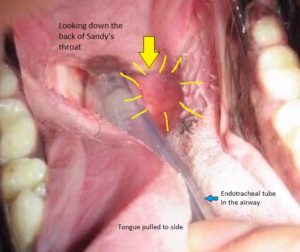
Sandy is a 5 year old black lab and redbone hound mix. Her owners adopted Sandy when she was 18 months old through a friend’s daughter. She was studying anthrozoology at Carroll College and part of her program was fostering/training dogs from the local dog shelter in Helena, MT. They met Sandy while she was being fostered; her sweet natured personality tugged at their hearts, and they adopted her when she was finished with her program.
Sandy was seen for her wellness exam and vaccines in the August of 2022 where her owner mentioned that she seems to breathe heavily on walks which they think seems more than normal. They said that this has been going on for a few months. Sandy was a little nervous to enter the hospital that day and was panting in the exam room. That is when we noticed that there was some hoarseness in her panting. Her physical exam was unremarkable with normal swallow reflex and no pain or palpable masses in the throat region.
The different causes of hoarse bark or voice change in dogs include-
- Inflammation of larynx from coughing, barking or gastroesophageal reflux.
- Inflammation of tonsils or vocal cords
- Laryngeal paralysis- is a condition in which the muscles that open the voice box become weakened due to a degenerative disease of the nerves and muscles. This results in difficulty in breathing, especially during stress or on hot humid days.
- Myasthenia Gravis – is an autoimmune disease that causes muscle weakness. This condition can be generalized but it can also cause focal muscle weakness, which only affects a few muscles around the dog’s face and neck resulting in vocal changes along with other clinical signs
- Laryngeal or oral masses causing obstruction of the airflow.
Sandy’s owner did not report any coughing or vomiting and she was not a barker.
Based on the history and physical exam early laryngeal paralysis was put high on the differential list. After discussing all the possible causes with her owner, a sedated oral exam targeting the laryngeal area was recommended along with radiographs of chest and throat.
Sandy came in for her sedated oral exam and radiographs at the end of the September. There was still the same hoarseness when she was panting along with some crusting of nose. The sedated oral exam revealed a laryngeal mass in the throat region. The mass was about the size of a walnut with a smooth surface on the left side of her larynx. It appeared to be attached to one of cartilages of the larynx.
She was intubated immediately to maintain the flow of oxygen to her lungs. Although the mass was deep down in her throat, we were able to get Fine Needle Aspirates for cytology with a long needle. Throat and chest radiographs were also performed.
Sandy was monitored closely during recovery after the sedation with special attention to her breathing and temperature as overheating is a concern in dogs where normal airflow is compromised. She recovered well and went home later that same day.
The results of the cytology report from the mass indicated the presence of an unusual, uncommon neoplasm. The possibility of a few specific tumors like rhabdomyoma, oncocytoma, granular cell tumor or rhabdomyosarcoma were listed by the pathologist. Biopsy of the mass with special staining was recommended to get a definitive diagnosis.
Sandy was referred to the oncologist for further evaluation (CT scan of head and neck, biopsy) and treatment. After the CT scan, and surgical evaluation of the mass under general anesthesia, a rhabdomyoma of the larynx was suspected. Treatment options for laryngeal neoplasia include surgical excision, chemotherapy, radiation therapy, or a combination thereof. Sandy’s owner’s explored all the possible treatment options including the radiation therapy. Upon further discussion with specialists, surgery to remove the mass or radiation therapy was not elected and she was started on chemotherapy.
Laryngeal tumors are rare in dogs. The clinical signs associated with laryngeal tumors include voice change, difficulty breathing, and coughing. In patients with laryngeal tumors, physical examination findings may vary depending on the size and location of the primary tumor. Direct visualization of larynx under sedation is the most helpful tool in differentiating various causes of above said clinical signs. Therefore it is important to include sedated oral exam as part of diagnostic work-up. Radiographs may also provide information regarding the size and extent of the tumor and any metastasis in the lungs.
Advanced imaging like CT scan or MRI allows the most accurate assessment of local invasion and regional lymph node status prior to surgical intervention.
Sandy continued to do well at home until a recent episode of aspiration pneumonia for which she needed hospitalization and treatment. She was seen at HHVH for a recheck exam and radiographs of her chest showed complete resolution of aspiration pneumonia. Sandy is in treatment currently with her oncologist and her owners are leaving no stone unturned to provide her comfort at home.
A Word from Sandy’s Owner
“She is a bit slower, and tires more easily, but she still has an excellent quality of life- eating like a lab, shorter walks, a lot less soccer ball dribbling or ball catching – a small bit, a lot of love given to her and spoiling while she is still on this earth”. 
Other links:
- Laryngeal paralysis- https://veterinarypartner.vin.com/default.aspx?pid=19239&id=4952489
- Myasthenia Gravis- https://veterinarypartner.vin.com/default.aspx?pid=19239&id=4951980



